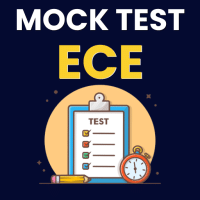Electronics and Communication Engineering (ECE) Exam > Electronics and Communication Engineering (ECE) Questions > For an RC phase-shift oscillator using BJT, R...
Start Learning for Free
For an RC phase-shift oscillator using BJT, R = 10 kΩ, C = 0.01 μ.F and Rc = 2.2 kΩ The minimum current gain needed for sustained oscillations is around
- a)156
- b)101
- c)96
- d)188
Correct answer is option 'A'. Can you explain this answer?
| FREE This question is part of | Download PDF Attempt this Test |
Verified Answer
For an RC phase-shift oscillator using BJT, R = 10 kΩ, C = 0.01 ...
For sustained oscillations, the minimum vaiue of current gain or forward current gain is

Most Upvoted Answer
For an RC phase-shift oscillator using BJT, R = 10 kΩ, C = 0.01 ...
In a RC phase-shift oscillator using BJT, R refers to the value of the resistor in the feedback network. A typical value for R in a RC phase-shift oscillator is 10 k ohms (kΩ).
The RC phase-shift oscillator is a type of oscillator circuit that uses a combination of resistors and capacitors to create a phase shift in the feedback signal, which helps to sustain oscillations. The BJT (Bipolar Junction Transistor) is used as the active component in this circuit.
The values of the resistors and capacitors in the feedback network determine the frequency of oscillation of the RC phase-shift oscillator. By selecting appropriate values for R and the capacitors, the desired frequency of oscillation can be achieved. Typically, three capacitors and three resistors are used in the feedback network to create the necessary phase shift.
It is important to note that the value of R alone does not determine the frequency of oscillation, but it is one of the components that contribute to the overall frequency response of the oscillator. The other components, such as the capacitors and the transistor characteristics, also play a role in determining the frequency of oscillation.
The RC phase-shift oscillator is a type of oscillator circuit that uses a combination of resistors and capacitors to create a phase shift in the feedback signal, which helps to sustain oscillations. The BJT (Bipolar Junction Transistor) is used as the active component in this circuit.
The values of the resistors and capacitors in the feedback network determine the frequency of oscillation of the RC phase-shift oscillator. By selecting appropriate values for R and the capacitors, the desired frequency of oscillation can be achieved. Typically, three capacitors and three resistors are used in the feedback network to create the necessary phase shift.
It is important to note that the value of R alone does not determine the frequency of oscillation, but it is one of the components that contribute to the overall frequency response of the oscillator. The other components, such as the capacitors and the transistor characteristics, also play a role in determining the frequency of oscillation.
Attention Electronics and Communication Engineering (ECE) Students!
To make sure you are not studying endlessly, EduRev has designed Electronics and Communication Engineering (ECE) study material, with Structured Courses, Videos, & Test Series. Plus get personalized analysis, doubt solving and improvement plans to achieve a great score in Electronics and Communication Engineering (ECE).

|
Explore Courses for Electronics and Communication Engineering (ECE) exam
|

|
Similar Electronics and Communication Engineering (ECE) Doubts
For an RC phase-shift oscillator using BJT, R = 10 kΩ, C = 0.01 μ.F and Rc = 2.2 kΩ The minimum current gain needed for sustained oscillations is arounda)156b)101c)96d)188Correct answer is option 'A'. Can you explain this answer?
Question Description
For an RC phase-shift oscillator using BJT, R = 10 kΩ, C = 0.01 μ.F and Rc = 2.2 kΩ The minimum current gain needed for sustained oscillations is arounda)156b)101c)96d)188Correct answer is option 'A'. Can you explain this answer? for Electronics and Communication Engineering (ECE) 2024 is part of Electronics and Communication Engineering (ECE) preparation. The Question and answers have been prepared according to the Electronics and Communication Engineering (ECE) exam syllabus. Information about For an RC phase-shift oscillator using BJT, R = 10 kΩ, C = 0.01 μ.F and Rc = 2.2 kΩ The minimum current gain needed for sustained oscillations is arounda)156b)101c)96d)188Correct answer is option 'A'. Can you explain this answer? covers all topics & solutions for Electronics and Communication Engineering (ECE) 2024 Exam. Find important definitions, questions, meanings, examples, exercises and tests below for For an RC phase-shift oscillator using BJT, R = 10 kΩ, C = 0.01 μ.F and Rc = 2.2 kΩ The minimum current gain needed for sustained oscillations is arounda)156b)101c)96d)188Correct answer is option 'A'. Can you explain this answer?.
For an RC phase-shift oscillator using BJT, R = 10 kΩ, C = 0.01 μ.F and Rc = 2.2 kΩ The minimum current gain needed for sustained oscillations is arounda)156b)101c)96d)188Correct answer is option 'A'. Can you explain this answer? for Electronics and Communication Engineering (ECE) 2024 is part of Electronics and Communication Engineering (ECE) preparation. The Question and answers have been prepared according to the Electronics and Communication Engineering (ECE) exam syllabus. Information about For an RC phase-shift oscillator using BJT, R = 10 kΩ, C = 0.01 μ.F and Rc = 2.2 kΩ The minimum current gain needed for sustained oscillations is arounda)156b)101c)96d)188Correct answer is option 'A'. Can you explain this answer? covers all topics & solutions for Electronics and Communication Engineering (ECE) 2024 Exam. Find important definitions, questions, meanings, examples, exercises and tests below for For an RC phase-shift oscillator using BJT, R = 10 kΩ, C = 0.01 μ.F and Rc = 2.2 kΩ The minimum current gain needed for sustained oscillations is arounda)156b)101c)96d)188Correct answer is option 'A'. Can you explain this answer?.
Solutions for For an RC phase-shift oscillator using BJT, R = 10 kΩ, C = 0.01 μ.F and Rc = 2.2 kΩ The minimum current gain needed for sustained oscillations is arounda)156b)101c)96d)188Correct answer is option 'A'. Can you explain this answer? in English & in Hindi are available as part of our courses for Electronics and Communication Engineering (ECE).
Download more important topics, notes, lectures and mock test series for Electronics and Communication Engineering (ECE) Exam by signing up for free.
Here you can find the meaning of For an RC phase-shift oscillator using BJT, R = 10 kΩ, C = 0.01 μ.F and Rc = 2.2 kΩ The minimum current gain needed for sustained oscillations is arounda)156b)101c)96d)188Correct answer is option 'A'. Can you explain this answer? defined & explained in the simplest way possible. Besides giving the explanation of
For an RC phase-shift oscillator using BJT, R = 10 kΩ, C = 0.01 μ.F and Rc = 2.2 kΩ The minimum current gain needed for sustained oscillations is arounda)156b)101c)96d)188Correct answer is option 'A'. Can you explain this answer?, a detailed solution for For an RC phase-shift oscillator using BJT, R = 10 kΩ, C = 0.01 μ.F and Rc = 2.2 kΩ The minimum current gain needed for sustained oscillations is arounda)156b)101c)96d)188Correct answer is option 'A'. Can you explain this answer? has been provided alongside types of For an RC phase-shift oscillator using BJT, R = 10 kΩ, C = 0.01 μ.F and Rc = 2.2 kΩ The minimum current gain needed for sustained oscillations is arounda)156b)101c)96d)188Correct answer is option 'A'. Can you explain this answer? theory, EduRev gives you an
ample number of questions to practice For an RC phase-shift oscillator using BJT, R = 10 kΩ, C = 0.01 μ.F and Rc = 2.2 kΩ The minimum current gain needed for sustained oscillations is arounda)156b)101c)96d)188Correct answer is option 'A'. Can you explain this answer? tests, examples and also practice Electronics and Communication Engineering (ECE) tests.

|
Explore Courses for Electronics and Communication Engineering (ECE) exam
|

|
Suggested Free Tests
Signup for Free!
Signup to see your scores go up within 7 days! Learn & Practice with 1000+ FREE Notes, Videos & Tests.
























